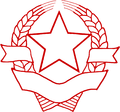| Emblem of Yugoslavia | |
|---|---|
 | |
| Versions | |
 Emblem of FPR Yugoslavia (1946–1963). This version featured five torches that represented the brotherhood and unity of the five Yugoslav nations. The sixth torch in the later version was added for the Bosnian Muslims. | |
 Emblem of Democratic Federal Yugoslavia (1943–1946). | |
| Armiger | Yugoslavia |
| Adopted | 1963 |
| Crest | Red star |
| Shield | Six torches burning together |
| Supporters | Wheat |
| Other elements | Blue ribbon with a text imprinting the date: 29 November 1943 |
| Use | As official emblem of Yugoslavia |
The Emblem of Yugoslavia featured six torches, surrounded by wheat with a red star at its top, and burning together in one flame; this represented the brotherhood and unity of the six federal republics forming Yugoslavia: Bosnia and Herzegovina, Croatia, Macedonia, Montenegro, Serbia and Slovenia. The date imprinted was 29 November 1943, the day the Anti-Fascist Council for the National Liberation of Yugoslavia (AVNOJ) met in Jajce on its second meeting and formed the basis for post-war organisation of the country, establishing a federal republic. This day was celebrated as Republic Day after the establishment of the republic. The emblem of Yugoslavia, along with those of its constituent republics, are an example of socialist-style emblems.










